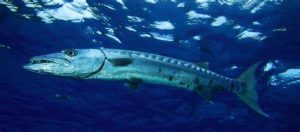
Barracuda
Appearance: Barracudas are large, predatory fish known for their sleek and elongated bodies. They have a cylindrical shape with a pointed head and a mouth full of sharp teeth. Their bodies are typically silver or gray in color, and they have a row of dark, distinct markings along their sides.
Size: Barracudas can vary in size depending on the species. The smaller species may measure around 2 to 3 feet (60 to 90 centimeters) in length, while larger species, such as the great barracuda, can reach lengths of up to 6 feet (1.8 meters) or more.
Range: Barracudas are found in warm and tropical waters around the world, particularly in the Atlantic, Pacific, and Indian Oceans. They inhabit coastal areas, reefs, mangroves, and open ocean environments.
Speed and Agility: Barracudas are known for their exceptional speed and agility. They are capable of swimming at high speeds, reaching bursts of up to 25 to 30 miles per hour (40 to 48 kilometers per hour) to catch their prey.
Predatory Behavior: Barracudas are apex predators and are opportunistic feeders. They have a voracious appetite and primarily feed on other fish, including smaller species, such as mullet, herring, and anchovies. They use their sharp teeth and swift swimming abilities to ambush and capture prey.
Hunting Strategy: Barracudas are known for their stalking and ambush hunting tactics. They often hide near structures, such as coral reefs or shipwrecks, and wait for an opportunity to strike their prey when it comes within range.
Adaptations: Barracudas possess several adaptations that make them effective predators. They have excellent vision, with eyes located high on their heads, allowing them to spot prey from a distance. Additionally, their bodies are hydrodynamic, allowing for rapid acceleration and precise maneuvering.
Threat to Humans: While barracudas are generally not aggressive towards humans, there have been rare instances where they have attacked humans, usually in response to being threatened or when mistaken for prey. However, such incidents are extremely rare, and barracudas are not typically considered a significant threat to humans.
Reproduction: Barracudas are oviparous, meaning they reproduce by laying eggs. Females release thousands of eggs into the water column, where they are fertilized externally by the males. The eggs hatch into larvae, which then grow and develop in the open water.
Conservation Status: The conservation status of barracuda species varies depending on the specific region and species. Some species, such as the great barracuda, are more abundant, while others may face threats due to overfishing and habitat degradation. It is important to practice responsible fishing and sustainable seafood consumption to help protect barracuda populations and their ecosystems.